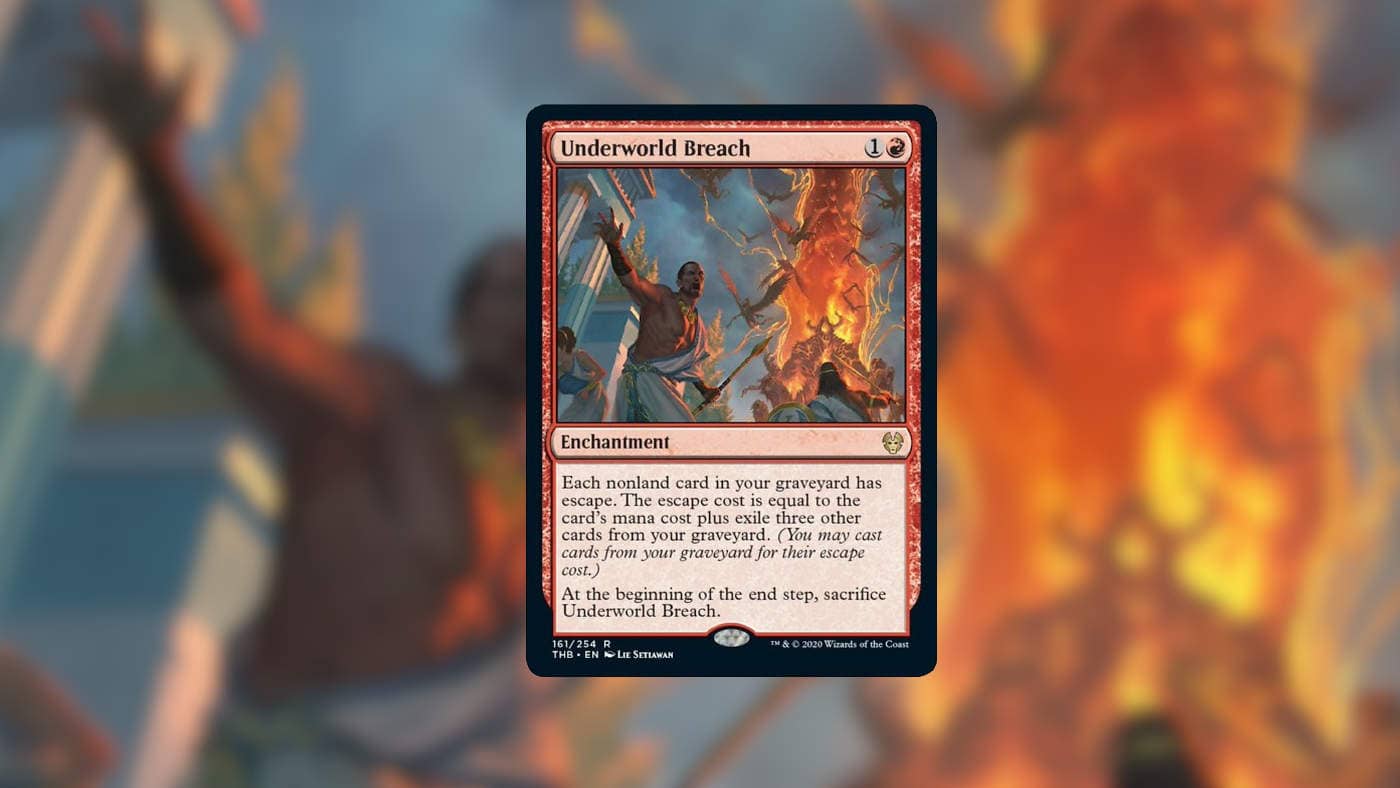2019 might be over, but the power level of cards in 2020 certainly is just as high. I mentioned in my
Wishclaw Talisman review that The EPIC Storm does not often get cards in Standard sets that are worth main deck consideration. As it turns out, it has been a little bit more often than that and
Theros: Beyond Death is no exception. This set has provided the incredibly powerful looking enchantment in the form of [[Underworld Breach]].
Underworld Breach
[[Underworld Breach|]]
[[Underworld Breach]]EnchantmentEach nonland card in your graveyard has escape. The escape cost is equal to the card’s mana cost plus exile three other cards from your graveyard. (You may cast cards from your graveyard for their escape cost.)At the beginning of the end step, sacrifice Underworld Breach.
[[Underworld Breach]] would fall into the category of engine cards. It provides a way to draw a lot of cards for a relatively low mana investment. There have been a couple of similar types of cards across the history of Magic, with some being unbelievable broken while others are currently unplayable.Looking at the different parts of the card, there are a couple of important lines on it. The
Escape mechanic falls in a really odd space. The closest comparisons are
Retrace and
Flashback. Because
Escape does not exile the card cast with it at any point, the same card may be escaped multiple times. [[Underworld Breach]] specifically states
"Each nonland card in your graveyard has Escape". This is relevant because the verb on the card is
"has" and not
"gains". To contrast with the
"gains" effect of [[Past in Flames]], cards that enter the graveyard after resolving [[Underworld Breach]] will have Escape. This means that when attempting to combo with this card, it does not matter when it resolves as it will have the same effect. There is a downside to
"has". If [[Underworld Breach]] is removed, the instant it leaves the battlefield, all of the cards in the graveyard lose Escape immediately, most likely ending the combo turn. Having the combo turn ended by a multitude of non-counter spells such as [[Abrupt Decay]], [[Disenchant]], and [[Force of Vigor]], is the biggest weakness of the card. One of the strengths of combo decks overall is that they often do not care about what a lot cards an opponent could have. [[Underworld Breach]] cares about a lot of cards because its effect only lasts as long as it is in play. That is the strength of
"gains", as once that happens nothing can take away the ability that was granted.
"The escape cost is equal to the card's mana cost plus exile three other cards from your graveyard". This is the line of text that balances the card. If every single card from a 60 card deck made it to the graveyard, you would be able to cast one spell 19 times in the same turn. This imposes quite a hard limit, but if the goal is to win with cards such as [[Grapeshot]] or [[Brain Freeze]], they can be cast multiple times for a kill. Exiling three cards is quite a large cost while playing [[Underworld Breach]] without any attempt at self-milling. It is likely that this will draw one or two cards without a dedicated way to put more cards into the graveyard. For that reason alone, [[Underworld Breach]] does not fit into an existing Storm shell. ANT does not want this card as it cannibalizes both [[Cabal Ritual]] and [[Past in Flames]]. With TES and especially the most recent versions, the deck does not put enough cards into the graveyard for [[Underworld Breach]] to be useful. This means that if the card is playable, it will have to prove that a new shell has some advantage over both of those decks.
Primed Engines
[[Underworld Breach]] is an engine card, but it is not the same type of engine card as something like [[Past in Flames]], [[Echo of Eons]], and [[Ad Nauseam]]. Those cards either require no setup or reward simply playing Magic. A primed engine, in contrast, is an engine card that requires some specific setup or work to make the card good. Some more recent examples of these are [[Bonus Round]] and [[Bolas's Citadel]]. These cards are extremely powerful given the right resources. The problem is with these types of cards is that often the amount of effort and cards needed to make them work leaves little room to actually win the game. BR Reanimator and Tin Fins show this dichotomy really well. BR Reanimator focuses on putting a [[Griselbrand]] or other large monster into play and winning with that directly. Tin Fins goes a step further and attempts to include a Storm kill and a [[Shallow Grave]] kill with [[Emrakul, the Aeons Torn]]. One of the reasons that RB Reanimator is a better deck is just that it is more focused. It acts as a basic
A+B combo deck, where Tin Fins uses [[Griselbrand]] as a primed engine.Any deck that focuses on being an [[Underworld Breach]] deck likely ends up with a bunch of cards that are good before resolving it and bad afterwards, as well as a bunch of cards that are bad beforehand and good after resolving it. Looking at most of the deck lists floating around with four [[Underworld Breach]] and four [[Brain Freeze]], this seems like an excessive number of win conditions and cards that are not that great to draw in multiples. One of the strengths of traditional storm is that it has a high number of tutor effects to find a low number of business spells. This makes these decks more flexible and have less redundant pieces, resulting in smoother draws.
Comparisons
[[Snapcaster Mage|]]
[[Yawgmoth's Will|]]
[[Regrowth|]]
[[Yawgmoth's Will]] is the most obvious place to start as a point of comparison. Both cards have a draw the graveyard effect, but have a few differences. [[Yawgmoth's Will]] only effects the cards already in the graveyard and each card in the graveyard can only be cast one more time. It is also an extra mana at an important break point: [[Underworld Breach]] nets mana with [[Lion's Eye Diamond]]. Given that [[Yawgmoth's Will]] is banned in Legacy, it seems unlikely that [[Underworld Breach]] and [[Yawgmoth's Will]] will ever have to worry about competing for slots. [[Underworld Breach]] is considerably less powerful than [[Yawgmoth's Will]], however, because it requires an enabler to be an engine. Where [[Yawgmoth's Will]] simply rewards you for playing Magic, [[Underworld Breach]] has a hard time being an engine without something kick starting it.Exploring a more fair comparison, [[Snapcaster Mage]] and [[Regrowth]] are very similar to [[Underworld Breach]] when it is played without an enabler. [[Snapcaster Mage]] has the advantage of being instant speed and also a creature. [[Regrowth]] returns the card to the hand, which has an advantage of spreading the cost out over a few turns. Effectively drawing 1-3 cards that have to be cast on the same turn as this card might be good enough for a fair shell or a Burn deck, but this is unlikely to be impactful enough for any sort of combo shell.
BUB - Brain Freeze Underworld Breach
[[Lion's Eye Diamond|]]
[[Underworld Breach|]]
[[Brain Freeze|]]
A lot of deck lists in this style have been running around. The basic idea is that [[Lion's Eye Diamond]], [[Brain Freeze]], and [[Underworld Breach]] combine together to mill the entire deck and then win with [[Grapeshot]], [[Brain Freeze]], or [[Laboratory Maniac]]/[[Jace, Wielder of Mysteries]]. While this is a powerful interaction, it is easily disrupt able through most forms of interaction. Many of the deck lists do not have a solid plan
B. One of the reasons that ANT and TES are so successful is the even when a plan
A is cut off, they can choose another plan and go around that hate. These BUB style decks require so many cards to win the game that there is not room for a plan
B.
[[Gamble|]]
[[Demonic Tutor|]]
[[Entomb|]]
One of the cooler interactions with [[Underworld Breach]] is that it turns both [[Gamble]] and [[Entomb]] into one-mana [[Demonic Tutor]] effects, and you can even repeat them! Granted, once one of those cards has resolved, it seems very unlikely that winning the game would require tutoring again.
Other Shells
An interesting shell where the the [[Brain Freeze]] [[Underworld Breach]] combo may be very good is in UR Painter. The deck already plays [[Lion's Eye Diamond]] and has a very solid plan
A to allow a copy or two of [[Brain Freeze]] to sneak into the deck. It also can put cards into the graveyard natural with [[Goblin Engineer]] and [[Grindstone]]. The [[Underworld Breach]] plan can act as a solid backup and recovery plan for that strategy.The other place where [[Underworld Breach]] is interesting is as a sideboard card in Burn for grindier match ups. Here it can be used in the fair mode to flashback 2-3 cards. It is probably similar to [[Light Up the Stage]], but it has a more static power level due to the mana cost being constant and being able to always draw good spells.
Summary
Strengths
- Very cheap
- Does not exile the escaped cards
- Cards added to the graveyard still can be escaped after [[Underworld Breach]] resolves
- Do not have to crack [[Lion's Eye Diamond]] with [[Underworld Breach]] on the stack
- High synergy with [[Entomb]] and [[Gamble]]
Weaknesses
- Can be removed to end the combo turn with cards like [[Abrupt Decay]] and [[Disenchant]]
- Without another engine to feed [[Underworld Breach]], it is hard to escape more than one or two cards
- Every piece of Legacy playable graveyard interaction answers [[Underworld Breach]].
- The number of cards that the strategy requires makes it very hard to fit other plans.
[[Underworld Breach]] is a fun card to read that gets the Johnny brain going. Unfortunately, the interactions it provides are not good enough for Legacy. There might be deck or two out there that can utilize it in a more fair manner, but a dedicated [[Underworld Breach]] combo deck is not resilient enough to make an impact in current Legacy.










